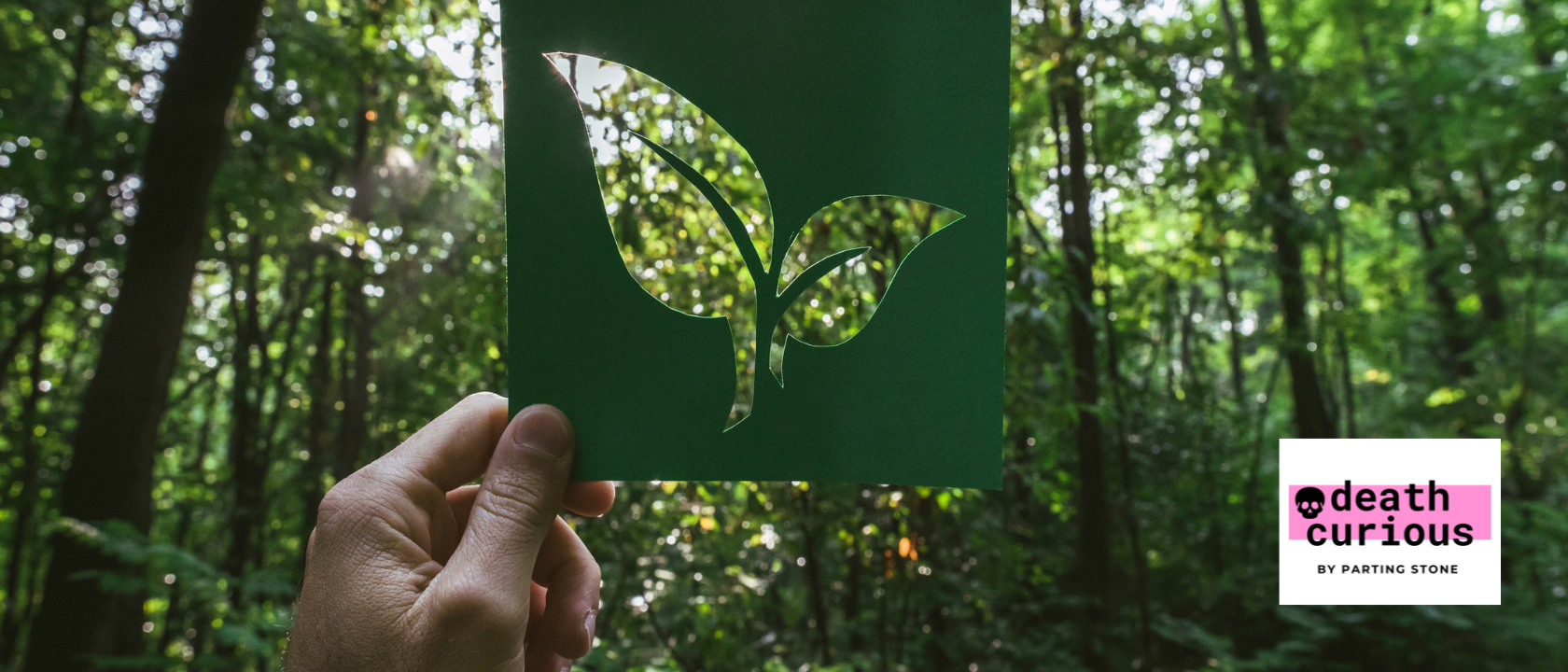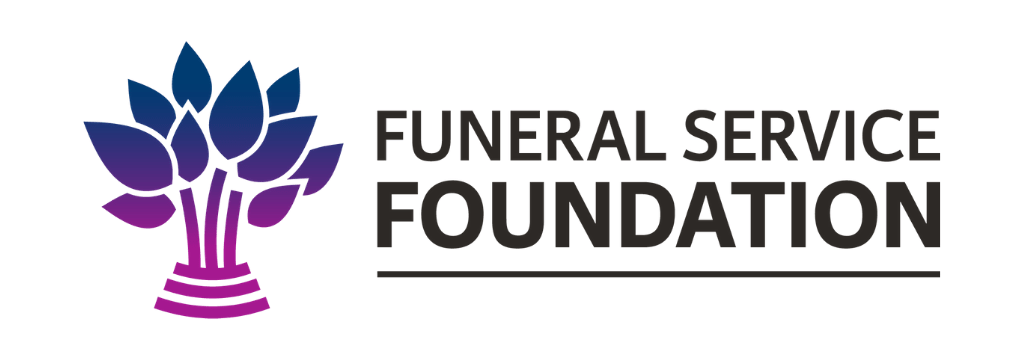Disposition’s Actual Eco-Impact, Part One of Five: Traditional Burial
This article was originally published on the Death Curious blog. Alexandra Jo and Parting Stone launched Death Curious with the mission of eliminating death avoidance and bringing people together with death-positive education. This is the first in a series of five deeply-researched articles exploring the real eco-impact of the various forms of disposition.
Research shows that consumers across generations want eco-conscious options across all products and services, and over 65% of consumers are willing to change their purchasing habits to be more “green.” A 2020 study on consumer purchasing habits by IBM Business Institute states that, “nearly six in 10 consumers surveyed are willing to change their shopping habits to reduce environmental impact. Nearly eight in 10 respondents indicate sustainability is important for them. And for those who say it is very/extremely important, over 70 percent would pay a premium of 35 percent, on average, for brands that are sustainable and environmentally responsible.” Death planning purchases are no exception to this rule.
In a 2021 study by Kates-Boylston Publications, research revealed that environmentally-friendly funerals/burials are extremely or very important to 68.2% of funeral planners, moderately important to 22.6%. Only 9.2% of death planners said environmentalism wasn’t important.
With new and greener disposition options gaining popularity each year, we did some research to figure out exactly how eco-friendly each disposition method (currently available in the U.S.) is, and what your death planning families need to know in order to make choices that are right for their beliefs and needs.
Traditional Burial
Favored by most funeral homes because of traditions instilled in the funeral industry throughout the 20th century, traditional burial including casketing and embalming the body was the chosen method for about 36.6% of people who died in 2021, according to the National Funeral Directors Association. Traditional casketed burial is now widely accepted by individuals as well as most religious faiths as a dignified, respectful way to dispose of our deceased loved ones. Furthermore, embalming offers many families the opportunity to say a formal and prolonged goodbye to the deceased.
Many deathcare professionals feel the need to rely on practices and services associated with traditional burial practices in order to sustain business and profitability. However, not only is this method steadily losing favor in the U.S. year over year, but it is also the disposition option with the highest, most damaging impact on the environment. Here’s a look at some of the most environmentally-harmful aspects of traditional burial.
Wood, Deforestation, and Land
Traditional burials with embalming require a casket to hold the deceased person’s body, and the majority of caskets in the U.S. are made from wood, or a combination of wood and metal. Caskets are often made from mined metals, toxic plastic or endangered wood. U.S. cemeteries use 30 million board-feet of hardwoods, and, according to Business Insider, the wood “is equivalent to about 4 million acres of forest and could build about 4.5 million homes.”
Other Materials Usage
Along with tons of wood, forest land, and land used for burial (about one million acres in U.S. cemeteries alone, according to one source), traditional burial uses large amounts of precious metals, concrete, stone, chemicals and other materials. The Funeral Consumers Alliance estimates that each year U.S. cemeteries bury “90,000 tons of steel in caskets, 17,000 tons of steel and copper in vaults, and 1.6 million tons of reinforced concrete in vaults.”
Along with the materials that go into casket construction and cemetery vaults, embalming fluids themselves still pose a big environmental problem, even when bodies are buried in caskets and vaults. Both the eventual breakdown of embalmed body and the casket and vault that it is entombed within, and the manufacturing and shipping of embalming fluids themselves have an impact on the environment.
An ebook called The Science of Green Burial says that, “The environmental impact of embalming is difficult to quantify as it includes the 4.3 million gallons of embalming fluid buried every year, and unidentifiable amounts of nonrenewable resources involved in the manufacture, shipping, and disposal of embalming products.” And that 4.3 million gallon figure could be too low. According to other sources, “Embalming bodies requires cancer-causing chemicals like formaldehyde, glutaraldehyde and phenol — in fact, in 2007 in the U.S., we buried more than 5 million gallons of embalming fluid, according to the Property and Environment Research Center.”
Additionally, an article from The Guardian outlines some of the environmental drawbacks of traditional burial like chemicals from coffins and materials eventually seeping into the soil, as well as other toxins such as radiotherapy or chemotherapy drugs. The article also reiterates that burial space is also becoming increasingly scarce and expensive in built-up areas.
Water Contamination
Water contamination is one area of significant environmental impact that is looked at in a comprehensive study comparing the eco-impact of traditional burial, flame cremation, and alkaline hydrolysis from the Netherlands. That study shows that 34.6 kg of pollution per burial enter water sources.
According to The Science of Green Burial ebook, most pollution of ground water found near cemeteries actually comes from embalming practices, chemicals, and the material components of buried coffins and fabrics, not the dead bodies themselves:
“The potential for contamination of drinking water due to body decomposition, though possible and frankly expected if best management practices are not followed, is not definitively substantiated by studies at this time. Areas adjacent to conventional cemeteries, especially historical cemeteries, have been reported to have elevated results when core soil and water specimens were tested for contaminants in a handful of cases. But there is no evidence that these findings are attributable to body decomposition processes. Due to the types of contaminants found, it is highly likely that the problems were caused by leachate from casket, vault, or embalming fluid or other incidental materials. No contamination has been reported from or near any green cemeteries in the U.S., Canada, Great Britain or Australia since their inception in 2003.”
Shipping Eco-Costs and Fossil Fuels
Additionally, we have to think about the environmental impact of harvesting and shipping all of that wood to casket manufacturers. While most funeral homes source caskets from domestic companies (the largest three being Batesville, Matthews, and Aurora), if any materials for caskets, headstones, embalming chemicals etc. like stone, wood, metal, come from overseas, the emissions for a traditional burial go way up.
According to GreenBiz.com:
“Big ships can use more than 110 tons of fuel oil per day and can take two weeks or more to traverse oceans. The fuel used in ships, for instance, still contains low levels of sulfur and is highly polluting, and it’s been estimated that shipping accounts for 3 to 4 percent of human-caused carbon emissions. A recent report from the European Parliament estimated that number could rise as high as 17 percent by 2050.”
Casket companies like Matthews boast efforts to reduce energy consumption and fuel usage in their U.S. manufacturing facilities, but it is unclear exactly where machinery, and casket materials are sourced from. It’s likely that at least some come from overseas.
Furthermore, some studies, like this one from the Netherlands, factors in the fossil fuels and greenhouse gas emissions that go into cemetery upkeep over time when looking at the whole carbon footprint of choosing a traditional burial. When looking at the whole picture, traditional burial uses far more fossil fuels and creates more greenhouse gas emissions than any of the other disposition methods currently used in the U.S. today.
What About Public Health and Embalming?
Many regulations around deathcare have been set based on the belief that the unembalmed dead bodies pose a threat to public health. However, this has been proven to be untrue by experts in many fields. Many scientists, in fact, argue that the greater public health risk comes from casketing for burial and embalming chemicals themselves. According to some sources, “Casket burials also prevent a corpse from decomposing efficiently, and this slow rotting process favors sulfur-loving bacteria, which can harm nearby water sources.”
Additionally, studies from the Green Burial Council performed by academics, licensed funeral directors, and doctors reveal:
“The medical community is of one opinion that embalming is a cosmetic procedure and is not in any way a public health safeguard. The more pressing medical issue related to embalming is the risk to embalmers and funeral directors from inhaling the vapors of embalming fluid, which contains formaldehyde, benzene, ethanol, ethylene glycol (an ingredient in antifreeze) and other toxic chemicals, causing: 13% higher death rate for embalmers (CDC) 8 times higher risk of contracting leukemia (11.24.09 Journal of National Cancer Institute) 3 times higher risk of contracting ALS and other auto-immune and neurological diseases (7.13.15 Journal of Neurology, Neurosurgery & Psychiatry). Despite this data, seven states require by law that infectious bodies (defined as likely to be transmitted to people, organisms, etc., through the environment) be embalmed.”
How does Traditional Burial Stack Up to Other Disposition Methods?
While traditional burial offers benefits to families wanting to say a prolonged goodbye, our research shows that it is the most environmentally impactful of all the disposition methods available in the U.S. today.
How To Make Traditional Burial More Eco-Friendly
Even so, deathcare professionals can’t deny that traditional burial still offers value and meaning for many families today. Being able to see a deceased loved one and say a final goodbye is important for many people, and embalming is often the only way to make this possible for the families that you serve. However, the fact remains that the majority of consumers are changing their purchasing habits to be more green and eco-friendly, and more and more families are seeking nontraditional memorial experiences, including greener options. To learn more about how you can make more eco-conscious choices in your traditional burial practices, download the free ebook, The Real Eco-Impact of Disposition Methods by clicking below:
In a presentation titled “Shifts in Customer Desires and Habits Brought on by The Pandemic” at the 2022 ICCFA Convention in Las Vegas, NV, Mary Russell of Matthews International shared insights from a recent survey of funeral planners, which revealed that a majority of death planners today are looking for non-traditional services and products, ways to make decisions online, and options for death planning that don’t require funeral visits.
In her presentation, Mary explained that “67% of today’s families are looking for non-traditional memorial and funeral services […] 74% of consumers want to see funeral service and product prices online so they can “shop” and make decisions from looking at the website, and 56% of surveyed don’t want to go into a funeral home or cemetery at all.”
The good news is that all of these consumer demands can contribute to making traditional burial a bit more green, at least in the planning stages. More online services mean less printing and paper usage at your business, and less gas used driving between destinations. The 67% of families looking for more non-traditional memorial services will probably have much overlap with the 65% of consumers willing to change purchasing habits to be more green.
Greener Disposition Now and In the Future
These changes are only expected to become more common and frequent as millennials and younger generations age into death planning, so in order to keep up with customer needs, funeral businesses should consider ways to make traditional burial services more green.
There are many ways that funeral homes can make traditional burial with embalming much more eco-friendly today. Using biodegradable caskets and finding formaldehyde-free embalming fluids are just a few on the long list of ways to improve burial practices for families and the environment. To learn more about how you can make more eco-conscious choices in your traditional burial practices, download the free ebook, The Real Eco-Impact of Disposition Methods:




